Geographically Weighted Negative Binomial Regression Model Predicts Wildfire Occurrence in the Great Xing’an Mountains Better Than Negative Binomial Model
Abstract
1. Introduction
2. Materials and Methods
2.1. Study Area
2.2. The Logical Framework of the Study
2.3. Data Collection
2.3.1. Response Variable
2.3.2. Predictor Variables
2.4. Model Description
2.5. Model Evaluation and Comparison
3. Results
3.1. Comparison of Significant Explanatory Variables between Two Models
3.2. Comparison of Model Fitting between GWNBR and Global NB
3.3. Spatial Autocorrelation of Residuals
3.4. Spatial Distribution of Fire Occurrence and Residual
4. Discussion
5. Conclusions
Author Contributions
Funding
Acknowledgments
Conflicts of Interest
References
- Mckenzie, D.; Shankar, U.; Keane, R.E.; Stavros, E.N.; Heilman, W.E.; Fox, D.G.; Riebau, A.C. Smoke consequences of new wildfire regimes driven by climate change. Earth’s Future 2014, 2, 35–59. [Google Scholar] [CrossRef]
- Guo, F.; Innes, L.J.; Wang, G.; Ma, X.; Sun, L.; Hu, H.; Su, Z. Historic distribution and driving factors of human-caused fires in the Chinese boreal forest between 1972 and 2005. J. Plant Ecol. 2015, 8, 480–490. [Google Scholar] [CrossRef]
- Wu, Z.; He, H.; Yang, J.; Liu, Z.; Liang, Y. Relative effects of climatic and local factors on fire occurrence in boreal forest landscapes of northeastern China. Sci. Total Environ. 2014, 493, 472–480. [Google Scholar] [CrossRef] [PubMed]
- Guo, F.; Selvalakshmi, S.; Lin, F.; Wang, G.; Wang, W.; Su, Z.; Liu, A. Geospatial information on geographical and human factors improved anthropogenic fire occurrence modeling in the Chinese boreal forest. Can. J. For. Res. 2016, 46, 582–594. [Google Scholar] [CrossRef]
- Guo, F.; Wang, G.; Innes, J.L.; Ma, Z.; Liu, A.; Lin, Y. Comparison of six generalized linear models for occurrence of lightning-induced fires in northern Daxing’an Mountains. China J. For. Res. 2016, 27, 379–388. [Google Scholar] [CrossRef]
- Guo, F.; Su, Z.; Wang, G.; Sun, L.; Tigabu, M.; Yang, X.; Hu, H. Understanding fire drivers and relative impacts in different Chinese forest ecosystems. Sci. Total Environ. 2017, 605, 411–425. [Google Scholar] [CrossRef] [PubMed]
- Martinez, J.; Vega-Garcia, C.; Chuvieco, E. Human-caused wildfire riskrating for prevention planning in Spain. J. Environ. Manag. 2009, 90, 1241–1252. [Google Scholar] [CrossRef] [PubMed]
- Niklasson, M.; Granstrom, A. Numbers and sizes of fires: Long-term spatially explicit fire history in a Swedish boreal landscape. Ecology 2000, 81, 1484–1499. [Google Scholar] [CrossRef]
- Oliveira, S.; Oehler, F.; San-Miguel-Ayanz, J.; Camia, A.; Pereira, J.M.C. Modeling spatial patterns of fire occurrence in Mediterranean Europe using Multiple Regression and Random Forest. For. Ecol. Manag. 2012, 275, 117–129. [Google Scholar] [CrossRef]
- Pradhan, B.; Suliman, M.D.H.B.; Awang, M.A.B. Forest fire susceptibility and risk mapping using remote sensing and geographical information systems (GIS). Disaster Prev. Manag. 2007, 16, 344–352. [Google Scholar] [CrossRef]
- Wallenius, T.H.; Kuuluvainen, T.; Vanha-Majamaa, I. Fire history in relation to site type and vegetation in Vienansalo wilderness in eastern Fennoscandia, Russia. Can. J. For. Res. 2004, 34, 1400–1409. [Google Scholar] [CrossRef]
- Pereira, M.G.; Trigo, R.M.; da Camara, C.C.; Pereira, J.M.C.; Leite, S.M. Synoptic patterns associated with large summer forest fires in Portugal. Agric. For. Meteorol. 2005, 129, 11–25. [Google Scholar] [CrossRef]
- Syphard, A.D.; Radeloff, V.C.; Keuler, N.S.; Taylor, R.S.; Hawbaker, T.J.; Stewart, S.I.; Clayton, M.K. Predicting spatial patterns of fire on a southern California landscape. Int. J. Wildland Fire 2008, 17, 602–613. [Google Scholar] [CrossRef]
- Hu, H. Forest Fire Ecology and Management, 2nd ed.; China Forestry Publishing House: Beijing, China, 2005; p. 66. [Google Scholar]
- Mandallaz, D.; Ye, R. Prediction of forest fires with Poisson model. Can. J. For. Res. 1997, 27, 1685–1694. [Google Scholar] [CrossRef]
- Griffith, D.A.; Haining, R. Beyond mule kicks: the Poisson distribution in geographical analysis. Geogr. Anal. 2006, 38, 123–139. [Google Scholar] [CrossRef]
- Podur, J.J.; Martell, D.L.; Stanford, D. A compound Poisson model for the annual area burned by forest fires in the province of Ontario. Environmetrics 2009, 21, 457–469. [Google Scholar] [CrossRef]
- Cameron, A.C.; Trivedi, P.K. Regression Analysis of Count Data; Cambridge University Press: Cambridge, UK, 1998. [Google Scholar]
- Anselin, L.; Griffith, D.A. Do spatial effects really matter in regression analysis? Pap. Reg. Sci. 1988, 65, 11–34. [Google Scholar] [CrossRef]
- Foody, G.M. Geographical weighting as a further refinement to regression modelling: an example focused on the NDVI-rainfall relationship. Remote Sens. Environ. 2003, 88, 283–293. [Google Scholar] [CrossRef]
- Wang, Q.; Ni, J.; Tenhunen, J. Application of a geographically-weighted regression analysis to estimate net primary production of Chinese forest ecosystems. Glob. Ecol. Biogeogr. 2005, 14, 379–393. [Google Scholar] [CrossRef]
- Koutsias, N.; Martínez, J.; Chuvieco, E.; AlligÖwer, B. Modeling wildland fire occurrence in southern Europe by a geographically weighted regression approach. In Proceedings of the 5th International Workshop on Remote Sensing and GIS Applications to Forest Fire Management: Fire Effects Assessment, Zaragoza, Spain, 16–18 June 2005; pp. 57–60. [Google Scholar]
- Padilla, M.; Vega-Garcia, C. On the comparative importance of fire danger rating indices and their integration with spatial and temporal variables for predicting daily human-caused fire occurrences in Spain. Int. J. Wildland Fire 2011, 20, 46–58. [Google Scholar] [CrossRef]
- Chuvieco, E.; Aguado, I.; Yebra, M.; Nieto, H.; Salas, P.J.; Martín, M.P. Development of a framework for fire risk assessment using remote sensing and geographic information system technologies. Ecol. Model. 2010, 221, 46–58. [Google Scholar] [CrossRef]
- Fotheringham, A.S.; Brunsdon, C.; Charlton, M.E. Geographically Weighted Regression: The Analysis of Spatially Varying Relationships; John Wiley and Sons: New York, NY, USA, 2002. [Google Scholar]
- Rodrigues, M.; De La Riva, J.; Fotheringham, S. Modeling the spatial variation of the explanatory factors of human-caused wildfires in Spain using geographically weighted logistic regression. Appl. Geogr. 2014, 48, 52–63. [Google Scholar] [CrossRef]
- Justice, C.O.; Giglio, L.; Korontzi, S.; Owens, J.; Morisette, J.T.; Roy, D.; Descloitres, J.; Alleaume, S.; Petitcolin, F.; Kaufman, Y. The MODIS fire products. Remote Sens. Environ. 2002, 83, 244–262. [Google Scholar] [CrossRef]
- Faivre, N.; Jin, Y.; Goulden, M.L.; Randerson, J.T. Controls on the spatial pattern of wildfire ignitions in Southern California. Int. J. Wildland Fire 2014, 23, 799. [Google Scholar] [CrossRef]
- Zhang, H.; Qi, P.; Guo, G. Improvement of fire danger modelling with geographically weighted logistic model. Int. J. Wildland Fire 2014, 23, 1130–1146. [Google Scholar] [CrossRef]
- Purevdorj, T.; Tateishi, R.; Ishiyama, T.; Honda, Y. Relationships between percent vegetation cover and vegetation indices. Int. J. Remote Sens. 1998, 19, 3519–3535. [Google Scholar] [CrossRef]
- Gutman, G.; Ignatov, A. The derivation of the green vegetation fraction from noaa/avhrr data for use in numerical weather prediction models. Int. J. Remote Sens. 1998, 9, 1533–1543. [Google Scholar] [CrossRef]
- McCulloch, C.E.; Searle, S.R. Generalized, Linear and Mixed Models; John Wiley & Sons: New York, NY, USA, 2001; pp. 1–184. [Google Scholar]
- Myers, R.H.; Montgomery, D.C.; Vining, G.G. Generalized Linear Models; John Wiley & Sons: New York, NY, USA, 2002; pp. 100–194. [Google Scholar]
- Da Silva, A.R.; Rodrigues, T.C.V. Geographically weighted negative binomial regression-incorporating overdispersion. Stat. Comput. 2014, 5, 769–783. [Google Scholar] [CrossRef]
- SAS Institute, Inc. STAT 9.4 Users’ Manual; SAS Institute, Inc.: Cary, NC, USA, 2013. [Google Scholar]
- Burnham, K.P.; Anderson, D.R. Multimodel inference: Understanding AIC and BIC in model selection. Sociol. Method. Res. 2004, 33, 261–304. [Google Scholar] [CrossRef]
- Bailey, T.C.; Gatrell, A.C. Interactive Spatial Data Analysis; Longman Scientific and Technical: Essex, UK, 1995. [Google Scholar]
- Chen, V.Y.J.; Deng, W.S.; Yang, T.C.; Matthews, S.A. Geographically weighted quantile regression (GWQR): An application to mortality data. Geogr. Anal. 2012, 44, 134–150. [Google Scholar] [CrossRef]
- Wu, W.; Zhang, L. Comparison of spatial and non-spatial logistic regression models for modeling the occurrence of cloud cover in northeastern Puerto Rico. Appl. Geogr. 2013, 37, 52–62. [Google Scholar] [CrossRef]
- Calkin, D.E.; Gebert, K.M.; Jones, J.G.; Neilson, R.P. Forest Service large fire area burned and suppression expenditure trends, 1970–2002. J. For. 2005, 103, 179–183. [Google Scholar] [CrossRef]
- Gabban, A.; San-Miguel-Ayanz, J.; Viegas, D.X. A comparative analysis of the use of NOAA-AVHRR NDVI and FWI data for forest fire risk assessment. Int. J. Remote Sens. 2008, 29, 5677–5687. [Google Scholar] [CrossRef]
- Lampin-Maillet, C.; Jappiot, M.; Long, M.; Bouillon, C.; Morge, D.; Ferrier, J.P. Mapping wildland-urban interfaces at large scales integrating housing density and vegetation aggregation for fire prevention in the South of France. J. Environ. Manag. 2010, 91, 732–741. [Google Scholar] [CrossRef]
- Liu, Z.; Yang, J.; Chang, Y.; Weisberg, P.J.; He, H.S. Spatial patterns and drivers of fire occurrence and its future trend under climate change in a boreal forest of Northeast China. Glob. Chang. Biol. 2012, 18, 2041–2056. [Google Scholar] [CrossRef]
- Hu, T.; Zhou, G. Drivers of lightning-and human-caused fire regimes in the Great Xing’an Mountains. For. Ecol. Manag. 2014, 329, 49–58. [Google Scholar] [CrossRef]
- Guo, F.T.; Wang, G.Y.; Su, Z.W.; Liang, H.L.; Wang, W.H.; Lin, F.F.; Liu, A.Q. What drives forest fire in Fujian, China? Evidence from logistic regression and Random Forests. Int. J. Wildland Fire 2016, 25, 505–519. [Google Scholar] [CrossRef]
- Jetz, W.; Rahbek, C.; Lichstein, J.W. Local and global approaches to spatial data analysis in ecology. Glob. Ecol. Biogeogr. 2005, 14, 97–98. [Google Scholar] [CrossRef]
- Guo, L.; Ma, Z.; Zhang, L. Comparison of bandwidth selection in application of geographically weighted regression: a case study. Can. J. For. Res. 2008, 38, 2526–2534. [Google Scholar] [CrossRef]
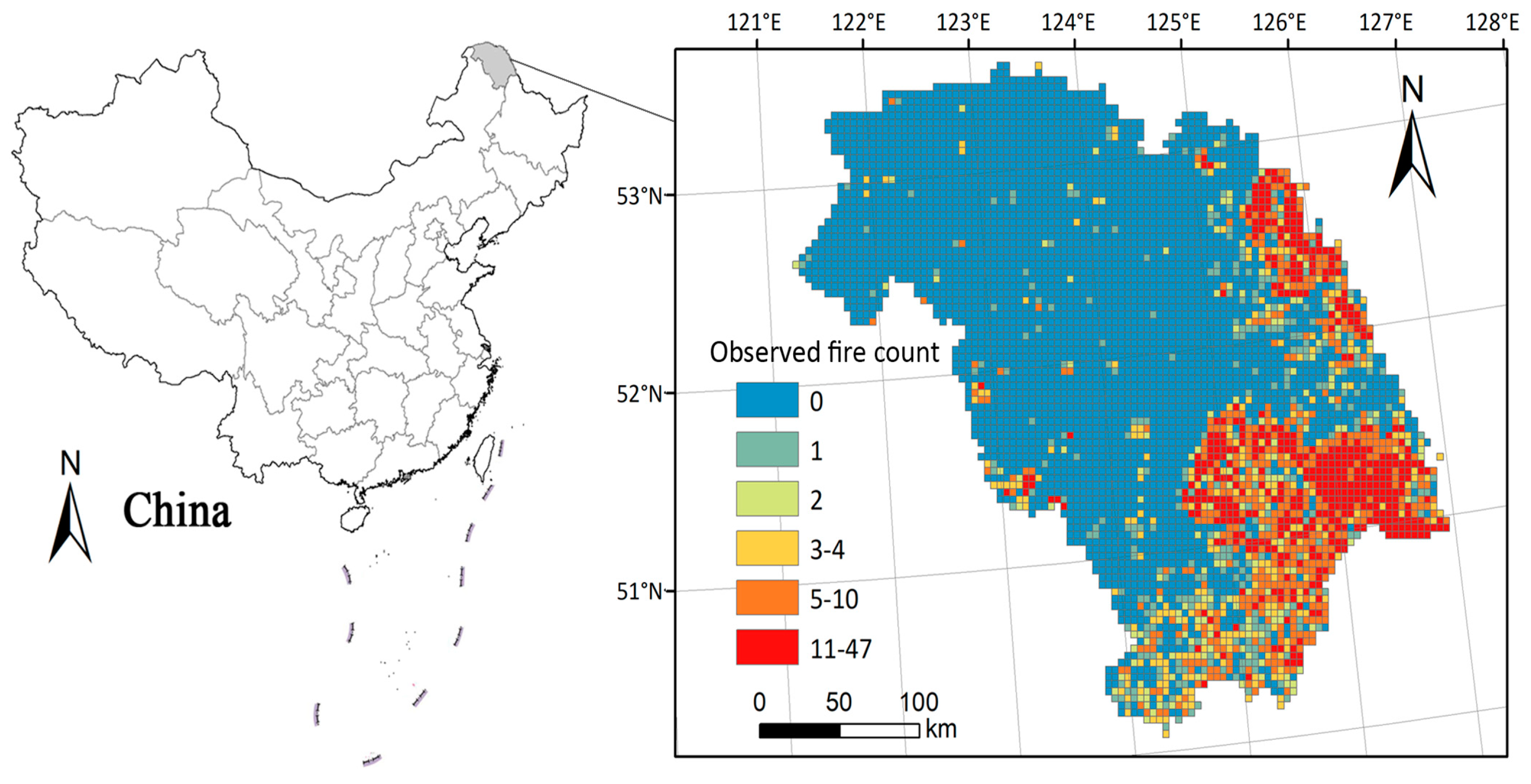
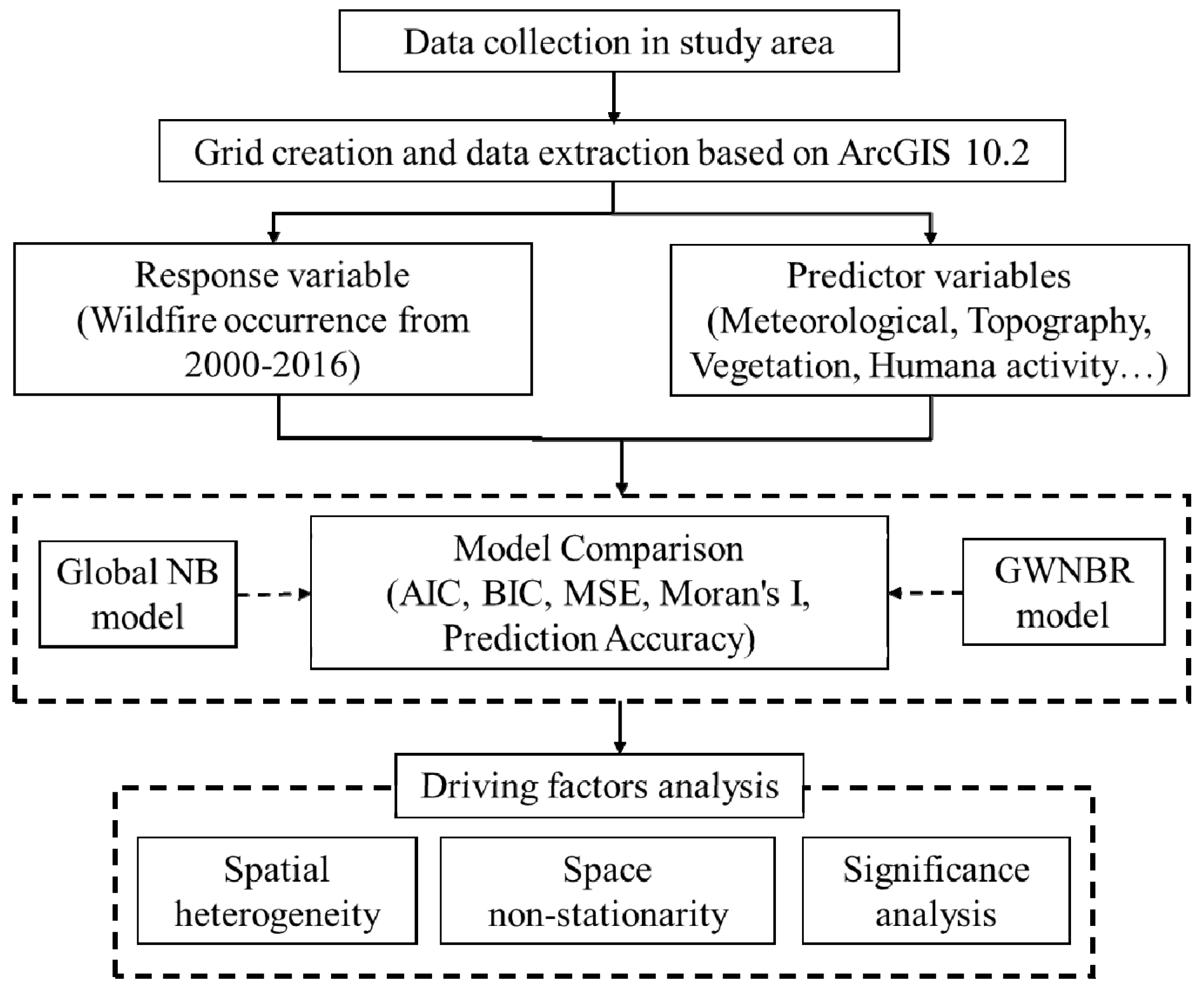
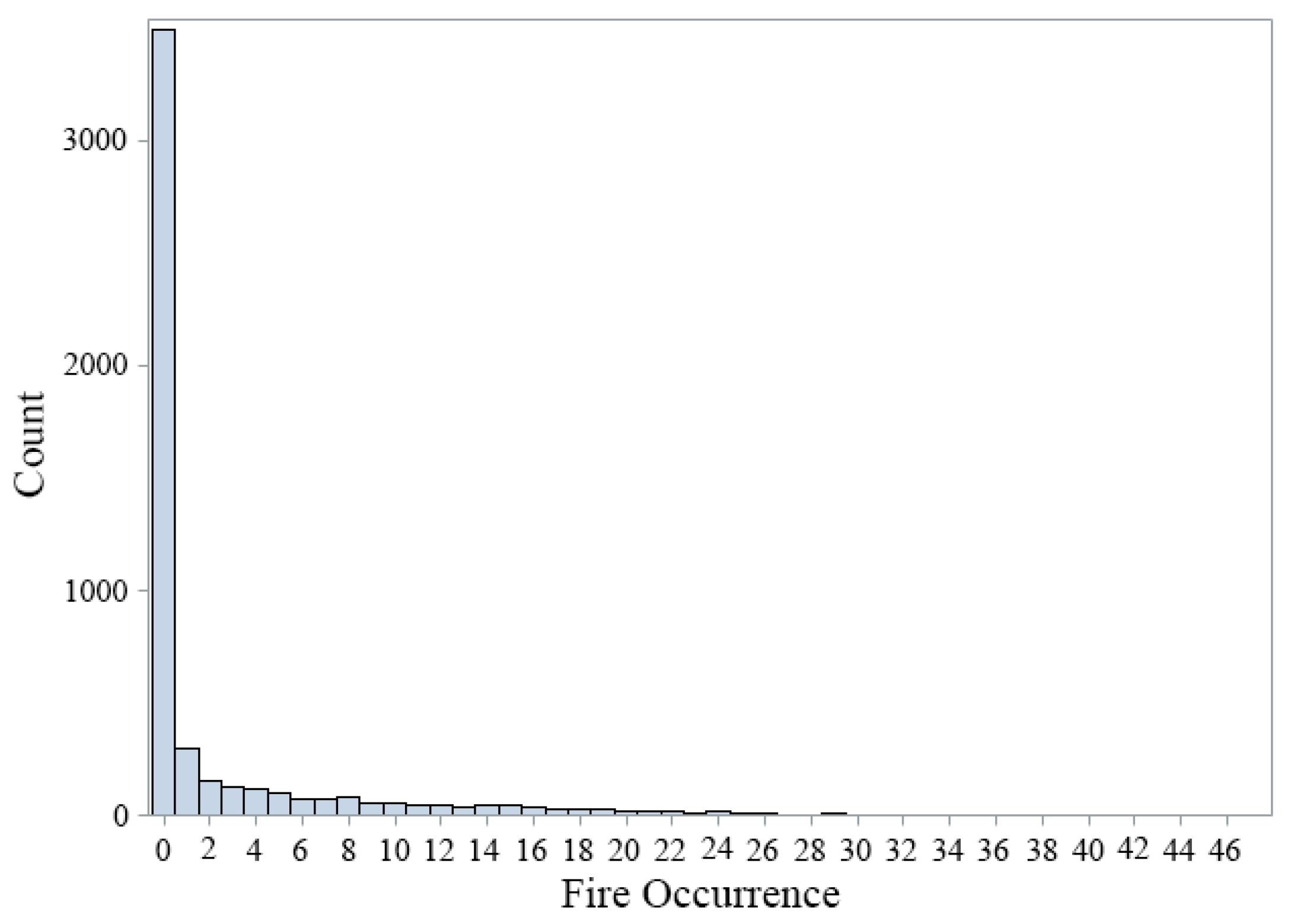
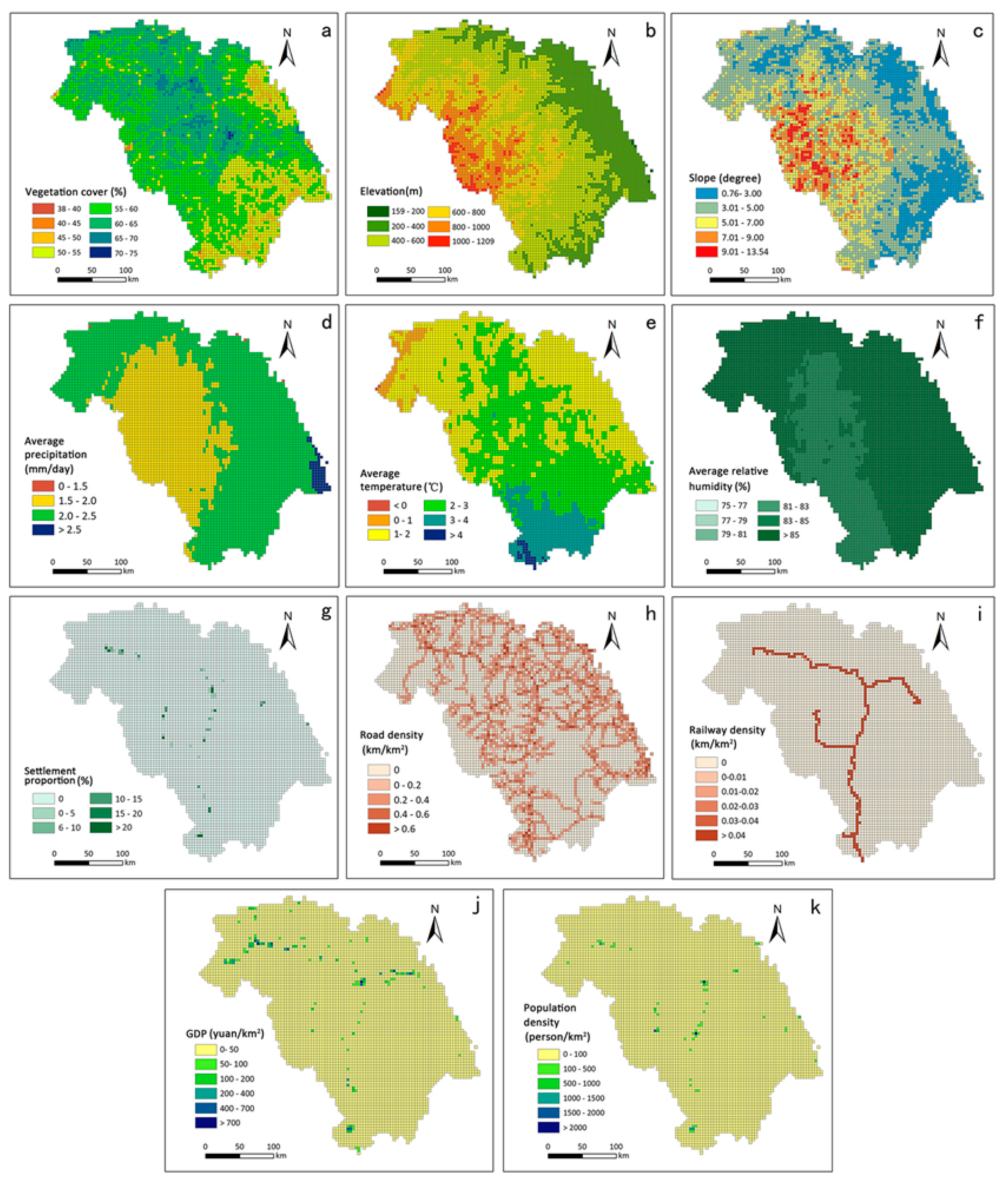
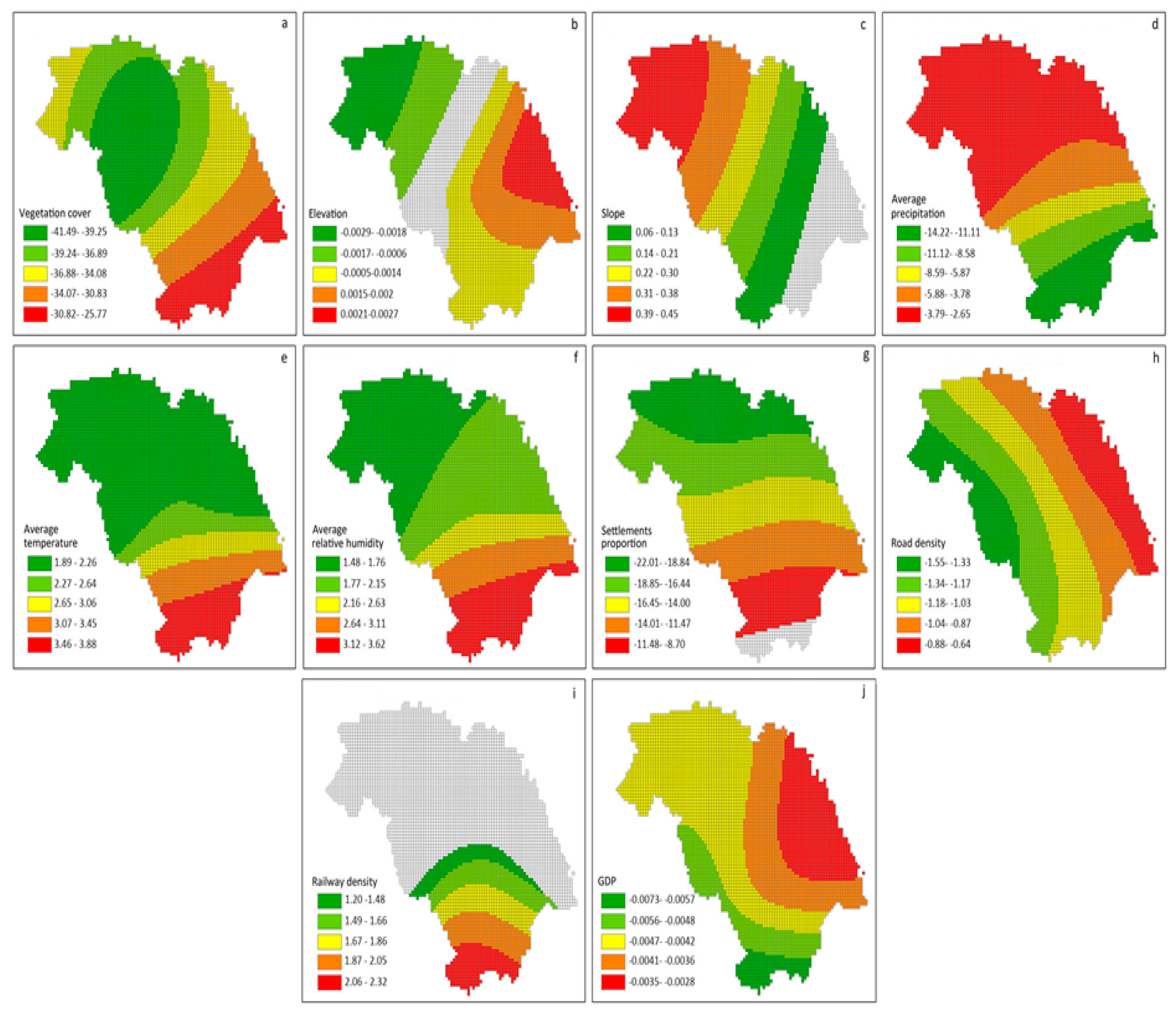
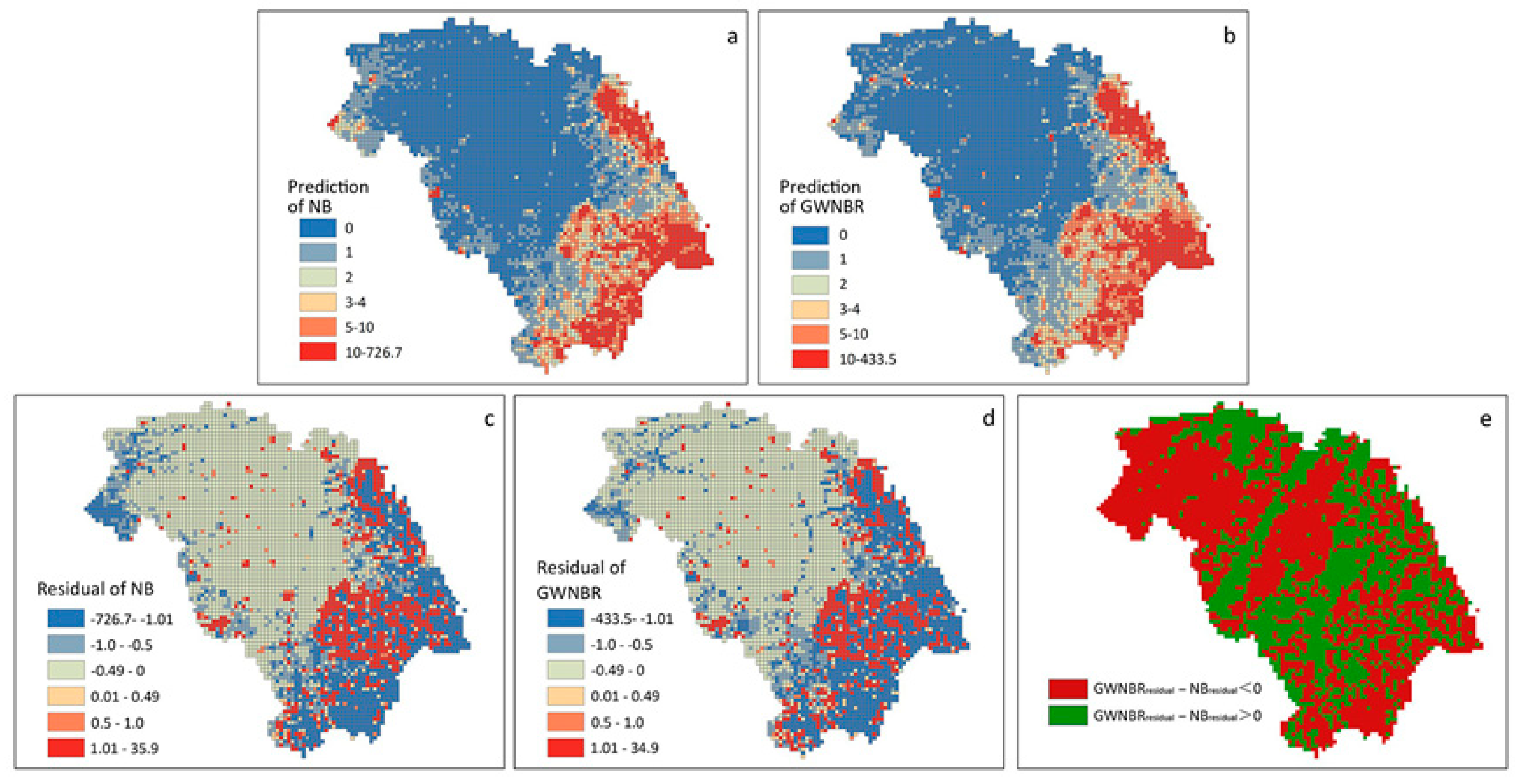
| Variables | Mean | Median | Minimum Value | Maximum Value | Standard Deviation |
|---|---|---|---|---|---|
| Fire Occurrence (point) | 2.54 | 0 | 0 | 47 | 5.6 |
| Elevation (m) | 551.8 | 519.9 | 159.4 | 1209.1 | 193.2 |
| Slope (degree) | 4.6 | 4.2 | 0.76 | 13.5 | 1.9 |
| Railway Density (km/km2) | 0.01 | 0 | 0 | 0.49 | 0.05 |
| Road Density (km/km2) | 0.12 | 0 | 0 | 0.89 | 0.16 |
| Settlement Proportion (%) | 0.001 | 0 | 0 | 0.558 | 0.016 |
| Average Rel. Humidity (%) | 85.9 | 85.7 | 74.9 | 89.2 | 1.2 |
| Average Temperature (°C) | 2.1 | 2.0 | −0.1 | 4.3 | 0.7 |
| Average Precipitation (mm/day) | 2.1 | 2.1 | −4.6 | 2.6 | 0.2 |
| Vegetation Cover (%) | 0.6 | 0.6 | 0.4 | 0.7 | 0.04 |
| GDP (Gross Domestic Product) (yuan/km2) | 6.9 | 1.9 | 0.03 | 853.7 | 34.2 |
| Population Density (person/km2) | 6.1 | 0 | 0 | 2688.4 | 69.1 |
| Statistics | βIntercept | βElevation | βSlope | βRailway density | βRoad density | βSettlement proportion | βAverage relative humidity | βAverage temperature | βAverage precipitation | βVegetation cover | βGDP | βPopulation density |
|---|---|---|---|---|---|---|---|---|---|---|---|---|
| Global negative binominal (NB) | ||||||||||||
| Estimate | −120.6 | −0.0002 | 0.27 | 0.92 | −1.07 | −14.63 | 1.67 | 1.91 | −3.16 | −38.15 | −0.005 | 0.0001 |
| Standard deviation | 9.4 | 0.0003 | 0.03 | 0.72 | 0.20 | 4.47 | 0.12 | 0.14 | 0.54 | 1.10 | 0.001 | 0.0008 |
| Estimate −1Std | −129.9 | −0.0005 | 0.24 | 0.20 | −1.28 | −19.10 | 1.56 | 1.76 | −3.70 | −39.25 | −0.006 | −0.0007 |
| Estimate + 1Std | −111.1 | 0.0001 | 0.29 | 1.64 | −0.87 | −10.17 | 1.79 | 2.05 | −2.62 | −37.05 | −0.004 | 0.0009 |
| Geographically weighted negative binominal regression (GWNBR) | ||||||||||||
| Minimum value | −275.3 | −0.0029 | −0.03 | −0.79 | −1.55 | −22.01 | 1.48 | 1.89 | −14.22 | −41.49 | −0.007 | −0.0012 |
| Lower quartiles | −201.5 | −0.001 | 0.09 | 0.08 | −1.24 | −18.47 | 1.66 | 2.09 | −8.18 | −39.42 | −0.005 | −0.0004 |
| Mean | −161.1 | 0.0003 | 0.22 | 0.82 | −1.10 | −15.50 | 2.18 | 2.48 | −5.58 | −36.17 | −0.004 | −0.0001 |
| Media | −142.1 | 0.001 | 0.21 | 0.92 | −1.10 | −15.97 | 1.92 | 2.15 | −3.67 | −36.86 | −0.004 | −0.0001 |
| Upper quartiles | −118.5 | 0.0015 | 0.35 | 1.51 | −0.94 | −12.74 | 2.68 | 2.87 | −2.97 | −33.53 | −0.004 | 0.0002 |
| Maximum value | −106.3 | 0.0027 | 0.45 | 2.32 | −0.64 | −7.55 | 3.62 | 3.88 | −2.65 | −25.77 | −0.003 | 0.0005 |
| Parameters | Estimate | Standard Error | p-Value |
|---|---|---|---|
| Intercept | −120.43 | 9.53 | <0.0001 |
| Slope | 0.25 | 0.02 | <0.0001 |
| Road density | −0.96 | 0.18 | <0.0001 |
| Settlement proportion | −14.03 | 4.22 | 0.0009 |
| Average relative humidity | 1.67 | 0.12 | <0.0001 |
| Average temperature | 1.92 | 0.14 | <0.0001 |
| Average precipitation | −3.09 | 0.56 | <0.0001 |
| Vegetation cover | −38.10 | 1.09 | <0.0001 |
| GDP | −0.01 | 0.001 | <0.0001 |
| Dispersion | 2.22 | 0.09 |
| All variables | Significant Variables | |||
|---|---|---|---|---|
| Statistics | Global NB | GWNBR | Global NB | GWNBR |
| AIC (Akaike information criterion) | 29442.17 | 22582.42 | 30138.93 | 23576.01 |
| BIC (Bayesian Information Criterion) | 29959.05 | 22609.66 | 30172.17 | 22760.81 |
| Prediction Accuracy | 62.99% | 68.23% | 62.4% | 68.6% |
| MSE (Mean Square Error) | 348.21 | 82.65 | 363.04 | 100.58 |
| Mean of absolute residuals | 5.94 | 2.77 | 5.9598 | 2.8911 |
| Std of Residuals | 18.56 | 9.04 | 18.9521 | 9.9755 |
| Moran’s Index | 0.042 | 0.02 | 0.041 | 0.0204 |
| Z-score | 118.2 | 56.3 | 114.5 | 57.3 |
| P-value | <0.0001 | <0.0001 | <0.0001 | <0.0001 |
| Coefficient | IQR(GWR) | SE (Global NB) | 2SE (Glzobal NB) | Status |
|---|---|---|---|---|
| Intercept | 83.07 | 9.41 | 18.83 | Non-stationary |
| Elevation | 0.002 | 0.0003 | 0.001 | Non-stationary |
| Slope | 0.26 | 0.03 | 0.06 | Non-stationary |
| Railway density | 1.43 | 0.72 | 1.44 | Stationary |
| Road density | 0.29 | 0.20 | 0.41 | Stationary |
| Settlement proportion | 5.74 | 4.47 | 8.94 | Stationary |
| Average relative humidity | 1.02 | 0.12 | 0.23 | Non-stationary |
| Average temperature | 0.78 | 0.14 | 0.29 | Non-stationary |
| Average precipitation | 5.20 | 0.54 | 1.08 | Non-stationary |
| Vegetation cover | 5.89 | 1.10 | 2.20 | Non-stationary |
| GDP | 0.001 | 0.001 | 0.002 | Stationary |
| Population density | 0.001 | 0.001 | 0.002 | Stationary |
| Dispersion | 0.61 | 0.09 | 0.1724 | - |
© 2019 by the authors. Licensee MDPI, Basel, Switzerland. This article is an open access article distributed under the terms and conditions of the Creative Commons Attribution (CC BY) license (http://creativecommons.org/licenses/by/4.0/).
Share and Cite
Su, Z.; Hu, H.; Tigabu, M.; Wang, G.; Zeng, A.; Guo, F. Geographically Weighted Negative Binomial Regression Model Predicts Wildfire Occurrence in the Great Xing’an Mountains Better Than Negative Binomial Model. Forests 2019, 10, 377. https://doi.org/10.3390/f10050377
Su Z, Hu H, Tigabu M, Wang G, Zeng A, Guo F. Geographically Weighted Negative Binomial Regression Model Predicts Wildfire Occurrence in the Great Xing’an Mountains Better Than Negative Binomial Model. Forests. 2019; 10(5):377. https://doi.org/10.3390/f10050377
Chicago/Turabian StyleSu, Zhangwen, Haiqing Hu, Mulualem Tigabu, Guangyu Wang, Aicong Zeng, and Futao Guo. 2019. "Geographically Weighted Negative Binomial Regression Model Predicts Wildfire Occurrence in the Great Xing’an Mountains Better Than Negative Binomial Model" Forests 10, no. 5: 377. https://doi.org/10.3390/f10050377
APA StyleSu, Z., Hu, H., Tigabu, M., Wang, G., Zeng, A., & Guo, F. (2019). Geographically Weighted Negative Binomial Regression Model Predicts Wildfire Occurrence in the Great Xing’an Mountains Better Than Negative Binomial Model. Forests, 10(5), 377. https://doi.org/10.3390/f10050377






